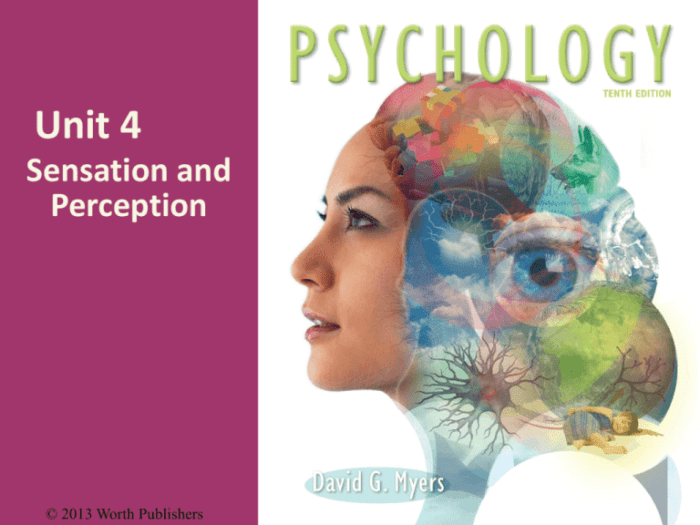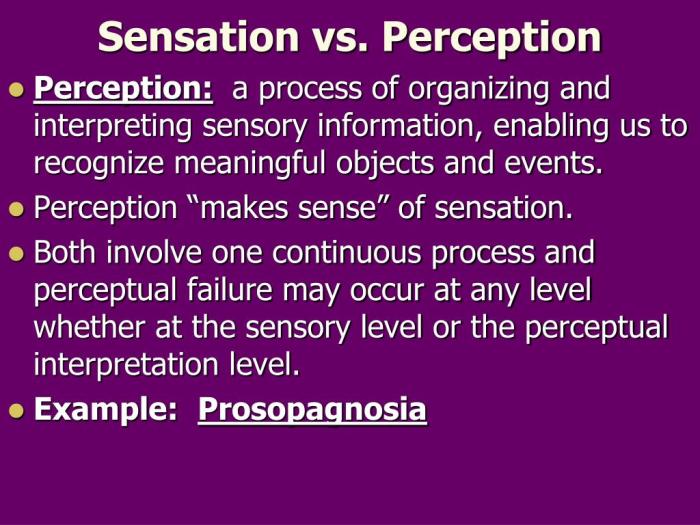Delving into Sensation and Perception 11th Edition, this comprehensive guide unlocks the gateway to sensory experience, providing a captivating exploration of the intricate processes that shape our perception of the world. Through an engaging narrative and authoritative tone, readers will embark on a journey that unravels the mysteries of sensation and perception, illuminating the physiological basis, sensory modalities, perceptual processes, and practical applications of these fundamental human experiences.
From the intricate workings of sensory receptors to the complex interplay of attention, recognition, and interpretation, this edition delves into the fascinating realm of sensory perception, revealing the profound influence of our expectations and experiences on the way we perceive the world around us.
Definition and Scope of Sensation and Perception

Sensation and perception are two fundamental processes that allow us to experience and interact with the world around us. Sensation refers to the process of detecting physical stimuli from the environment, while perception is the process of interpreting and organizing these stimuli into meaningful experiences.
Sensation and perception are closely related processes. Sensation provides the raw data that perception uses to construct our understanding of the world. For example, when we see a red apple, the sensation of light entering our eyes is processed by our brain to create the perception of a red object.
There are many different types of sensations and perceptions. The five senses of sight, hearing, touch, taste, and smell are the most well-known, but there are also many other types of sensations, such as pain, temperature, and balance.
Physiological Basis of Sensation and Perception, Sensation and perception 11th edition
Sensory receptors are specialized cells that detect physical stimuli and convert them into neural signals. There are different types of sensory receptors for each type of sensation. For example, photoreceptors in the eyes detect light, while thermoreceptors in the skin detect temperature.
When a sensory receptor is stimulated, it sends a neural signal to the brain. The brain then processes this signal and creates a perception of the stimulus. The process of sensation and perception is very fast, and we are usually not aware of the steps involved.
Sensory Modalities

The five senses of sight, hearing, touch, taste, and smell are the most well-known sensory modalities. Each modality has its own unique characteristics and functions.
- Visionis the sense of sight. It allows us to see the world around us and to perceive light, color, and form.
- Hearingis the sense of sound. It allows us to hear sounds and to perceive pitch, loudness, and timbre.
- Touchis the sense of touch. It allows us to feel objects and to perceive temperature, pressure, and pain.
- Tasteis the sense of taste. It allows us to taste food and to perceive sweetness, sourness, bitterness, and saltiness.
- Smellis the sense of smell. It allows us to smell odors and to perceive pleasant and unpleasant scents.
Perceptual Processes: Sensation And Perception 11th Edition
Perceptual processes are the steps involved in interpreting and organizing sensory information into meaningful experiences. These processes include attention, recognition, and interpretation.
Attentionis the process of focusing on specific stimuli. We can only process a limited amount of information at a time, so we must attend to the most important stimuli.
Recognitionis the process of identifying stimuli. We can recognize objects, faces, and other stimuli by comparing them to our stored memories.
Interpretationis the process of giving meaning to stimuli. We interpret stimuli based on our expectations, experiences, and knowledge.
Sensory Disorders and Illusions
Sensory disorders are conditions that affect the ability to sense stimuli. Common sensory disorders include color blindness and hearing loss.
Perceptual illusions are distortions of perception that occur when the brain misinterprets sensory information. Common perceptual illusions include the Müller-Lyer illusion and the Ponzo illusion.
Applications of Sensation and Perception
Sensation and perception have a wide range of applications in fields such as medicine, psychology, and technology.
In medicine, sensation and perception are used to diagnose and treat a variety of conditions. For example, doctors use sensory tests to check for hearing loss and color blindness.
In psychology, sensation and perception are used to study how people experience and interact with the world around them. For example, psychologists use perceptual illusions to study how the brain processes information.
In technology, sensation and perception are used to develop new products and services. For example, engineers use sensory research to design cars that are more comfortable and safer.
FAQs
What are the key differences between sensation and perception?
Sensation refers to the initial detection of physical stimuli by sensory receptors, while perception involves the interpretation and organization of sensory information into meaningful experiences.
How do sensory receptors convert stimuli into neural signals?
Sensory receptors transduce physical stimuli into electrical signals through various mechanisms, such as ion channel activation, chemical reactions, and mechanical deformation.
What is the role of top-down and bottom-up processing in perception?
Top-down processing involves the influence of expectations and prior knowledge on perception, while bottom-up processing refers to the direct processing of sensory information from the environment.
